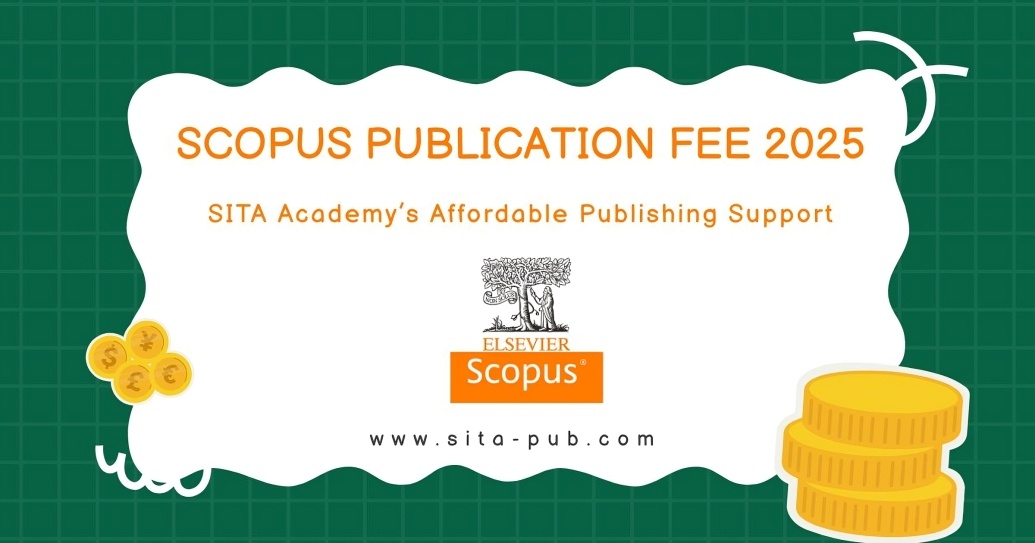Scopus Publication Fee 2025 – SITA Academy’s Affordable Publishing Support


Publishing in a reputable, indexed journal is the goal of many researchers. If your field is science, biology, biotechnology, agriculture, or natural resources, aiming for a journal indexed in Scopus is a common choice.
But one key question arises: how much does it cost? What are the Scopus publication fee realities in 2025?
In this article, we’ll examine:
Typical publication fees for Scopus journals
Factors influencing the cost (quartile ranking, field, open-access vs subscription, etc.)
How SITA Academy can help you navigate publishing efficiently and affordably
In academic publishing, “publication fee” usually refers to the Article Processing Charge (APC)—the cost associated with publishing a paper in a journal indexed in Scopus.
Although Scopus is just an indexing service, many journals listed there operate business models where authors pay fees to publish.
Here are some observations for 2025 APCs:
Open-access journals generally charge an APC. For example, IEEE lists an APC of USD 2,075 for most of their fully open-access journals.
APCs for most journals range from USD 500 to over USD 5,000, depending on publisher, field, and prestige.
Hybrid journals (subscription journals with optional OA) often charge higher fees than fully OA journals.
Some journals charge no APCs or only modest fees for page over-length or color figures, making them more accessible for authors with a limited budget.

Tier / Model | Approximate Fee Range (USD) | Notes |
Low-cost / Non-OA / Society-sponsored | 0 – 500 | Some journals waive fees, especially in low-income regions |
Standard Open Access (Q3-Q4, moderate prestige) | 500 – 1,500 | Many mid-tier journals fall here |
Higher Prestige Open Access / Hybrid | 1,500 – 4,000+ | Hybrids, Q1/Q2 journals, big publishers charge more |
Premium / Q1 / High-impact / Large Publisher | 4,000 – 8,900+ | Max for fully OA around USD 8,900; hybrids up to USD 12,690 |
Note: These are approximate ranges. Each journal has its own policy, currency, waiver options, and regional discounts. Always check the journal’s “For Authors” webpage.
Several factors determine the final cost of publishing in a Scopus-indexed journal:
Journals are rated Q1 to Q4 based on metrics like CiteScore or SJR.
Q1/Q2 journals generally charge more due to higher prestige and rigorous editorial processes.
Q3/Q4 journals often have lower fees.
Publishing in biology, biotechnology, agriculture, or natural resources may involve extra costs for color figures, supplementary data, or intensive peer review.
Journals in humanities or social sciences often have lower fees.
Fully Open Access (Gold OA): Authors pay APC; readers access content freely. Higher fee.
Subscription / Traditional: Readers or institutions pay; authors may pay little or no APC.
Hybrid: Subscription journals offering optional OA often charge more than full OA journals.
Large publishers (Elsevier, Springer, Wiley) charge more due to branding, typesetting, marketing, and archiving.
Smaller or regional journals tend to be cheaper.
Many journals provide APC discounts or full waivers for authors from low-income or lower-middle-income countries.
For example, Springer Nature offers full waivers for certain countries and 50% discounts for lower-middle-income economies.
Beyond APC, journals may charge for:
Page over-length
Color figures
Supplementary materials
Fast-track review
Extra authors
These contribute to the total Scopus publication cost.
Some journals offer fast-track options (sometimes with higher fees) if you need quick publication.
Tight deadlines may increase operational costs, which are passed on to authors.
At SITA Academy, our services are designed to help you publish in Scopus-indexed journals efficiently while keeping costs manageable.

Journal Recommendations:
We suggest journals aligned with your research scope, publication timeline, and budget.
End-to-End Support:
From formatting your manuscript to submitting it to the journal, we guide you every step.
Additional Services to Improve Technical Quality:
Native English Editing – best for non-native speakers
Plagiarism Checking & Removal
Layout & Figure Formatting Support
Thesis to Article Conversion:
Don’t have a ready paper? We can extract a publishable article from your Master’s or PhD thesis.
Budgeting Assistance:
We help estimate the total Scopus publication fee, including hidden costs, and assist in waivers or discounts if available.
Using affordable in our title emphasizes budget-friendliness, while inside the article we highlight reasonable pricing—fees that are fair and justified based on quality and service.
Before committing, consider these tips:
Verify Scopus-Indexing: Ensure the journal is currently indexed in Scopus.
Check the Journal’s Website: Look for APC, page charges, and waiver policies.
Match Scope & Audience: Submitting outside your field increases rejection risk and may waste money.
Calculate Full Cost: Include APC + color figure charges + page over-length + fast-track fees.
Avoid Predatory Journals: Some claim Scopus indexing but are low-quality exploitative journals.
Consider Budget & Funding: Target lower-fee journals or those offering waivers if needed.
Assess Timeline: Check review and publication speed. Fast-track may cost extra.
Plan Ahead: Ensure your manuscript is well-prepared to avoid desk rejection.

Publishing in Scopus-indexed journals is crucial for researchers seeking credibility and global reach. However, the Scopus publication fee is not fixed—it depends on:
Journal prestige / quartile
Field and discipline
Publisher and business model
Additional services or fast-track options
In 2025, fees typically range from USD 500 to several thousand dollars, though low-cost or waived options exist.
We help you make smart, cost-effective decisions:
Aligning journals with your research scope, timeline, and budget
Providing affordable and reasonable support throughout the publication process
Assisting with technical quality improvements, manuscript preparation, and thesis-to-article conversion
Our mission is to make your next publication efficient, affordable, and aligned with your academic goals.
If you have any questions, inquiries, or would like to learn more about our services, please don't hesitate to reach out to us. Our dedicated team is ready to assist you.